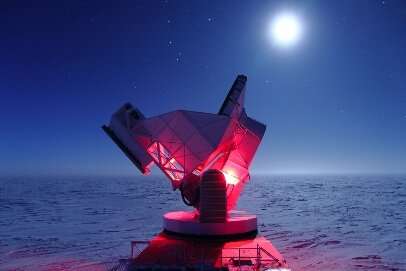Tracer galaxies probe the cosmic background

The universe, perhaps surprisingly, is not comprised of galaxies randomly distributed throughout space; that is, it is not very homogeneous. Instead, its galaxies are clustered into distinct structures, typically gigantic filaments separated by vast voids—the "large-scale structure (LSS)," an architecture whose discovery and mappings were pioneered by CfA astronomers about thirty years ago. Astronomers since have combined LSS maps with results from the cosmic microwave background radiation (CMBR) and ideas about the inflationary big bang to assemble a remarkably consistent picture of the universe, its origins and its evolution.
Mysteries remain, for example dark matter, which is also expected to gather in large-scale structures. CfA astronomers David James and Tony Stark were members of a large international team that used photons from galaxies in the early universe ("tracer galaxies") to probe the LSS in more detail. As these photons traverse the universe on their way to us, their paths are perturbed by the gravitational influences of the LSS, including in particular the effects of gravitational lensing. The apparent placements of young galaxies as projected on the sky and their statistical distributions are sensitive both to the current and the evolving geometry and structure of matter in the universe.
The astronomers recognized that although the details of the projected mass distribution are extremely complex, using the ratios of some parameters could obviate some uncertainties, enabling them to obtain important constraints on the current models of cosmic evolution. The team combined observations from the Dark Energy Survey (an optical survey that has mapped millions of galaxies), the South Pole Telescope (a submillimeter-wave facility studying the CMBR and early galaxies), and the Planck mission (a far infrared and millimeter survey spacecraft). One particularly valuable advantage of this approach is that it does not require knowing the distances to the tracer galaxies (distances would require their being able to measure the faint spectroscopic redshifts). The scientists were able to obtain constraints with a precision of about ten percent on some of the detailed parameters of current cosmological models, and they forecast that with further research these techniques will even enable them to constrain some of the essential features of dark matter, like its equatrion of state, and properties that have so-far remained elusive.
More information: J Prat et al. Cosmological lensing ratios with DES Y1, SPT, and Planck, Monthly Notices of the Royal Astronomical Society (2019). DOI: 10.1093/mnras/stz1309
Journal information: Monthly Notices of the Royal Astronomical Society
Provided by Harvard-Smithsonian Center for Astrophysics





















